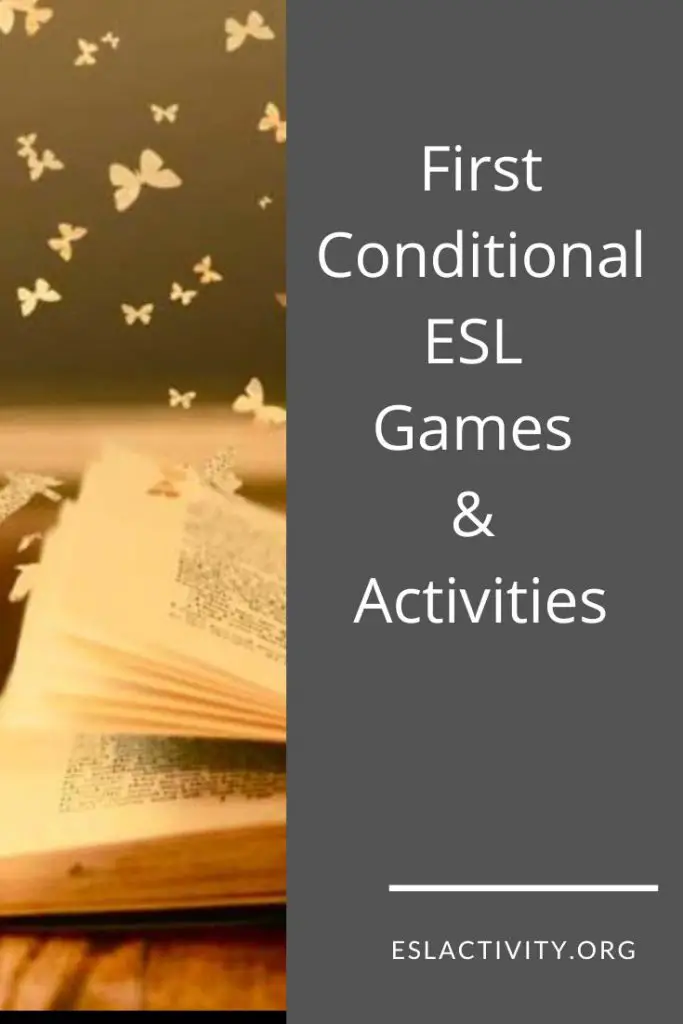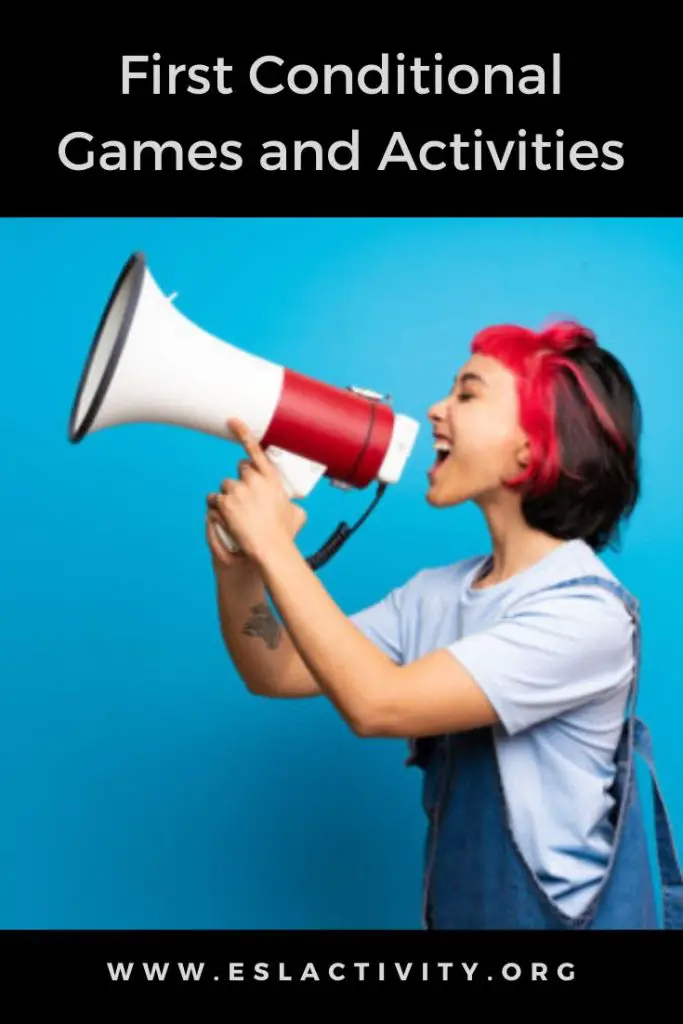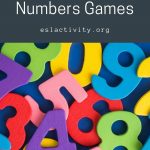If you’re looking for some of the best first conditional games and activities, then you’re definitely in the right place! We have more than 20 1st conditional ideas, along with worksheets, lesson plans, online practice recommendations and more.

First conditional games and activities
First Conditional Structure
In case you need a primer for what the 1st conditional structure is, here it is! We use it to talk about future situations that we believe are real or possible. Some examples:
- If it doesn’t rain tomorrow, we’ll go for a bike ride.
- If the Oilers win this game, they’ll be first in their division.
- I’ll let you know if I finish work early and can play.
The structure is usually:
If + present simple + will + infinitive (if can also be in the middle of the sentence).
It’s also possible to replace “if” with the following:
- unless (Unless you do your homework regularly, you’ll fail that class).
- as long as (As long as I’m happy, I’ll stay at that job).
- as soon as (As soon as I’m done work, I’ll come home).
- in case (I’ll give you a key in case I’m not home tomorrow).
More ideas for teaching conditionals here: Zero Conditional Worksheets, Third Conditional Games and Teaching the Second Conditional.
First Conditional Activities and Games
Let’s get into the best first conditional speaking activities for all ages!
#1: Three in a Row
Make up a worksheet with a bunch of result clauses. Then, put students into pairs and each pair will play against another pair (4 students total) with one of the worksheets. The goal is to get three squares in a row.
One partner says an “if” clause. Their partner can use one of the result clauses on the worksheet. If it makes sense, they mark the square off as theirs and the other teams goes.
#2: Dicto Gloss Activity
This is a challenging listening activity for higher-level students. Find or write a passage with a few first conditional statements. Then, put students into pairs and read it out at a faster than usual pace. Students have to take notes and try to recreate what they just heard. Repeat the process and then students compare their version with the original one. Find out more about it:
#3: Running Dictation
This is one of my favourite 4-skills ESL activities for all ages! Find, or write a conversation that makes good use of 1st conditional statements (the textbook you’re using may have a good one). Then, students have to work together to dictate the convo and then put it into the correct order. Find out more about it:
#4: Concentration
This is a fun memory game that helps students focus on meanings and 1st conditional statements. Make some sentences and then put each clause on a separate card. For example:
- If it rains / I won’t go to the beach
- If I finish my homework / I’ll go to the party tonight
- As long as Tammy is my boss / I’ll stay at that job
Then, students have to match cards. Check it out:
#5: Mixed Up Sentences
This is a nice activity for helping students work on forms. Make a bunch of sentences using the 1st conditional and mix them up in terms of word order. Students have to work with a partner to unscramble them.
#6: The Conditional Chain
Start the game off by saying the first half of a first conditional statement. The next player has to add a clause to complete the statement. The next player takes that new clause and makes a new first half of the statement. Does that make sense? Keep going, adding new clauses. The teacher or other classmates can assist students who can’t come up with something.
#7: Dialogue Substitution
Have you ever noticed that students seem to just kind of blow through dialogues that they have to read with a partner and they don’t really pay attention to what they’re reading? One of the best ways to combat this is to remove some of the key words. They can be things related to grammar or meaning. Find out more about it here:
#8: Is that Sentence Correct?
Conditional statements involve somewhat tricky grammar. The word order can sometimes be confusing which is why I like to do this simple activity. I make a bunch of sentences using the target grammar and in pairs, students have to decide if the sentence is correct. If it’s incorrect, they have to change it. Find out more here:
Is that Sentence Correct Activity?
#9: Pass the Paper
In this activity, students write down four clauses. Two are the first half of a first conditional and two of them are the last half. Then, they pass the paper to a partner who finishes the statements.
#10: Sentence Structure Activities
Conditionals are heavy on the sentence structure! They can get a little bit tricky, particularly if you teach about more than one of them in a single lesson. Students really have to master word order and verb tenses for this one. Have a look here at some of the best ideas for this:
ESL Sentence Structure Activities.
#11: First Conditional Speaking Lesson Plan
It’s easier than you might think to plan a lesson about almost anything. Check out this video for the steps to follow:
#12: Partner Conversation Starters
If you tell students to use the first conditional and talk to their partners, you may be met with silence! It’s entirely the teacher’s fault! The students haven’t really been given enough to work with.
Instead, help students out by giving them some conversation starters or questions. For example,
- If this class finishes early, what will you do?
- If you get the day off tomorrow, what will you do?
#13: The Flyswatter Game
To focus on meaning, write the second half of numerous 1st conditional statements on the whiteboard. One student from each team comes up to the board and takes a flyswatter. It works best to have mostly generic kinds of statements that could fit a bunch of different situations.
The teacher says the first half of one of the statements and then the first student to slap something that fits gets a point for their team. Learn more about it:
#14: Consider Using the Test Teach Test Approach
It’s likely that your students may already be familiar with conditionals. If that’s the case, why not give them a little bit of a test first to see what they know? Then, tailor the lesson to what they don’t. After that, give them another little test to see what they’ve picked up.
This kind of lesson can be a nice way to tailor the lesson specifically to the needs of the students. It’s also a change of pace from the usual presentation-practice-production model. Learn more about it here:
#15: First Conditional Movies and TV Clips
If you take a look on YouTube, you’ll see a ton of compilations of clips from popular TV shows and movies that use this grammatical structure. This can make a nice warm-up or review activity or form the basis of an entire lesson. Have a quick look around and you’re sure to find something that’ll work.
#16: Me Too!
Me Too is a simple speaking and listening activity that can help students get some practice with these kinds of statements. Students say a true statement that uses the target grammar. If other students could say the same thing about themselves, they stand up and say, “Me too!”
#17: Error Correction Relay Race
I love this game because it takes something old and boring (error correction) and turns it into something fun. Write a passage with the target grammar, and then make a few mistakes. Make sure you tell students how many mistakes there are.
In teams, students have to work together to find them all. You can find out more about it right here:
#18: Vocabulary Auction
If you want to have some fun with making sentences in your class, this is the game to play! Find out how to do it:
#19: Dictation Practice
Dictation is a nice activity to focus on forms. Dictate some questions that use the target grammar for the students. They have to write them down and then answer the question. Alternatively, you could dictate some statements and they have to make up the questions.
#20: Person on the Street Interview Activity
This is a fun way to make something old (talking with a partner). Students have to chat with someone on the street to get their opinions or ideas about something. In this case, they’d have to use a 1st conditional question. Check it out:
Person on the Street Interview Activity.
#21: Real-Life Scenarios
Present students with real-life scenarios or dilemmas that they might encounter. For example, “If you forget your homework, what will you do?” or “If you are running late for a bus, how will you catch it?” Have students discuss and share their ideas using the first conditional structure.
#22: Mix and Match
Create a set of sentence cards, with the condition on one card and the consequence on another. Shuffle the cards and distribute them to students. Students must find their match by pairing the condition and consequence cards, forming complete first conditional sentences.
#23: Song Lyrics Analysis
Choose a song that contains examples of the first conditional, and provide students with the lyrics. Have them identify and underline the first conditional sentences in the song. Then, discuss the meaning and context of those sentences, encouraging students to reflect on how the first conditional is used in popular culture.
#24: Story Writing
Ask students to write short stories that incorporate the first conditional. Provide them with a starting sentence or a prompt that sets up a condition, and have them develop the story based on the consequences that would occur. Students can then share and discuss their stories with their classmates.
More Ideas for Teaching English Grammar
- Amazon Kindle Edition
- Bolen, Jackie (Author)
- English (Publication Language)
- 112 Pages - 10/24/2019 (Publication Date)
The key to better TEFL classes is a wide variety of student-centred, engaging and interactive games and activities. This is particularly true for teaching grammar concepts like conditionals.
Not to worry though! Pick up a copy of 39 No-Prep, Low-Prep ESL Grammar Activities to help you have more interesting classes, the easy way. You’ll be able to make it through an entire semester in style and your students will keep coming back for more.
Pick up a copy of the book today and get ready for better English lessons tomorrow.
First Conditional Games Online
My students often ask me to recommend some online games to them so that they can practice their English grammar. Here are some of my favourite options for the 1st conditional:
Grammar Worksheet First Conditional
Check out these worksheets for additional practice:
First Conditional Lesson Plans
Save some time and effort by using lesson plans that others have already made! Here are some of the top recommendations:
FAQs about the 1st Conditional
There are a number of common questions that people have. Here are the answers to some of the most popular ones.
What are some first conditional examples?
Some first conditional examples are:
- If it rains, I won’t go hiking.
- She’ll miss the train if she doesn’t leave soon.
What are the four types of conditionals?
The four types of conditionals are zero, first, second, and third.
How do you teach the first conditional?
To teach the first conditional, be sure to set the context of the lesson. Then, focus on meaning and forms and give students some practice opportunities. Assign some homework and don’t forget review in the next lesson.
How can I introduce the first conditional to ESL students?
Start by explaining that it’s used for real or likely future situations. Use everyday examples to illustrate the structure and meaning.
What are some common first conditional keywords or phrases?
Words like “if,” “unless,” “when,” and “provided that” are often used to introduce the condition in the first conditional.
Can you provide some example sentences in the first conditional?
Sure, here are a few: “If she studies, she will pass the exam.” “I’ll be late unless you call me.” “If it snows, we can go sledding.”
How can I practice the first conditional with ESL students?
Use role-plays, create situations where students make predictions or decisions, and have them write sentences using the first conditional.
What’s the difference between the zero conditional and the first conditional?
The zero conditional is used for general truths or facts, while the first conditional is used for specific future situations based on real conditions.
Are there any common errors ESL students make with the first conditional?
Students often mistakenly use “will” in both parts of the sentence instead of just in the result clause. Regular practice helps correct this.
How can I make teaching the 1st conditional more engaging?
Use interactive activities like problem-solving scenarios, discussions about future plans, and fun games that involve making predictions.
Can you recommend any resources or materials for teaching the first conditional?
You can find worksheets, online exercises, and textbooks designed for teaching conditionals in ESL that offer structured practice and examples.
What’s the main goal when teaching the 1st conditional?
The main goal is for students to understand and use the structure correctly to discuss future events based on real conditions, making them more proficient in practical English.

First conditional speaking activities and games
Tips for How to Teach the First Conditional
Teaching the first conditional to ESL students can be engaging and effective with the right approach. Here are some tips to help you:
Start with Context
Begin by introducing the first conditional in a context that is relevant and relatable to your students. Use situations they can easily imagine or have experienced.
Use Clear Examples
Provide clear and simple examples of the first conditional structure, highlighting the if-clause and the main clause. For example, “If it rains, we will stay inside.”
Focus on Meaning
Help students understand that the first conditional is used to talk about real, possible situations in the future. Emphasize the idea of cause and effect.
Practice Form
Practice forming the first conditional sentences, paying attention to the verb tenses used (present simple in the if-clause, and future simple with ‘will’ or ‘going to’ in the main clause).
Use Visuals
Use visuals such as diagrams or illustrations to help students visualize the structure of the first conditional.
Provide Guided Practice
Give students opportunities to practice using the first conditional in controlled activities, such as completing sentences or matching sentence halves.
Encourage Production
Encourage students to use the first conditional in speaking and writing activities. Provide prompts or situations for them to respond to using the first conditional.
Provide Feedback
Offer constructive feedback on students’ use of the first conditional, focusing on both accuracy and fluency.
Use Games and Activities
Incorporate games and interactive activities to make learning the first conditional fun and engaging. For example, you could play a board game where students form first conditional sentences based on prompts.
Review and Reinforce
Regularly review the first conditional structure and provide opportunities for students to reinforce their understanding through practice.
- Amazon Kindle Edition
- Bolen, Jackie (Author)
- English (Publication Language)
- 154 Pages - 01/03/2023 (Publication Date)
First Conditional Activities: Join the Conversation
Do you have any first conditional speaking activities that you’d like to add to the list? Leave a comment below and let us know what you think. We’d love to hear from you.
Last update on 2022-07-17 / Affiliate links / Images from Amazon Product Advertising API






